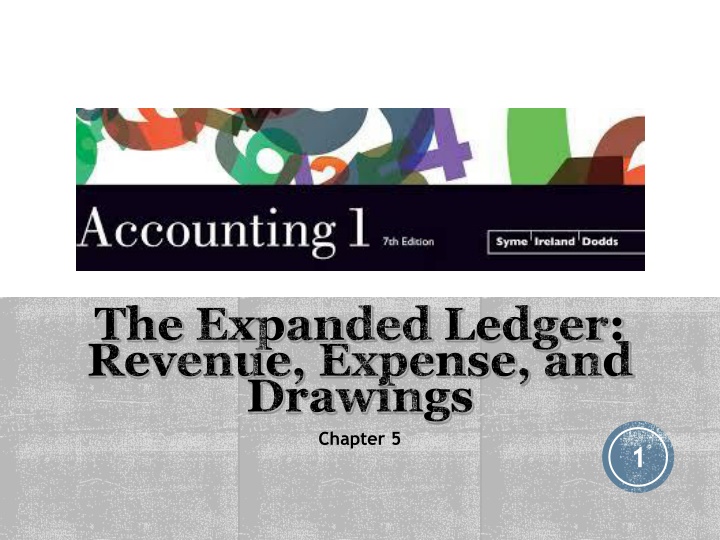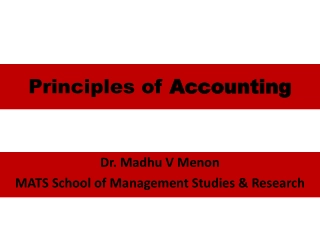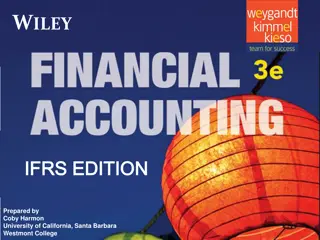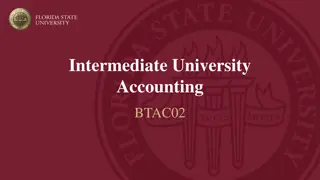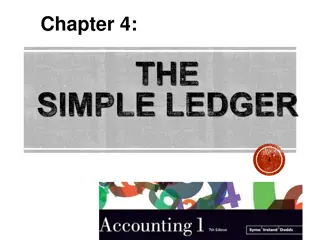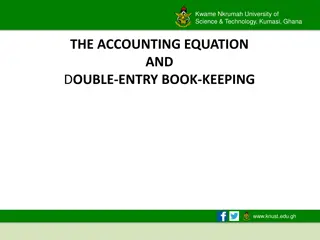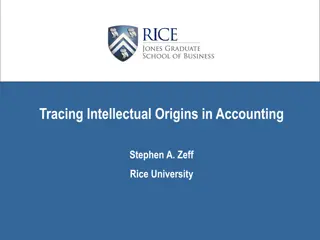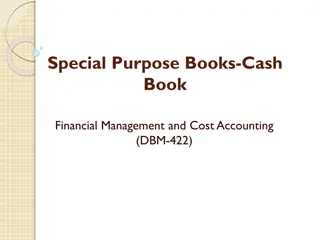The Expanded Ledger in Accounting
In this study on the expanded ledger, we delve into tracking revenue, expenses, and owner's equity in accounting, exploring entries, profitability assessment, and economic impacts on the owner's equity. Discover how to ascertain a company's profit or loss through ledger expansion.
Uploaded on Feb 27, 2025 | 1 Views
Download Presentation

Please find below an Image/Link to download the presentation.
The content on the website is provided AS IS for your information and personal use only. It may not be sold, licensed, or shared on other websites without obtaining consent from the author.If you encounter any issues during the download, it is possible that the publisher has removed the file from their server.
You are allowed to download the files provided on this website for personal or commercial use, subject to the condition that they are used lawfully. All files are the property of their respective owners.
The content on the website is provided AS IS for your information and personal use only. It may not be sold, licensed, or shared on other websites without obtaining consent from the author.
E N D
Presentation Transcript
The Expanded Ledger: Revenue, Expense, and Drawings Chapter 5 1
Expanding the Ledger 2
Real Life: Personal Net Worth Statement and the Budget 3
Expanding the Ledger Through the first four chapters we have looked at the fundamental accounting equation Assets = Liabilities +Owner s Equity This resulted in a single account for owner s equity. By default , what types of entries have you charged to owner s equity? 4
Types of OE Entries? 1. Owner s investment in the company. 2. Revenues from the sale of goods or by providing a service. 3. Expenses related to the operation of the business and the generation of revenues. 4. Drawings or owner s withdrawals from the business for personal use. 5
Expanding the Ledger The focus of Chapter 5 is the specific identification and use of accounts to track REVENUES EXPENSES DRAWINGS 6
Expanding the Ledger The purpose of expanding the ledger is to provide essential information about the progress of the business. This information is needed to assess the ongoing profitability of the company. What do we mean when we say a company is profitable or making a profit? What is meant by loss? 7
Example of Expanding the Ledger What do we know about profitability of this firm in the month of January? Did they make a profit or a loss? 8
Example of Expanding the Ledger How much was spent on advertising? Are the wages fair? Is the rent too high? How much did the owner withdraw from the business? What types of economic events can we speculate impacted the owner s equity account? 9
Example of Expanding the Ledger Now what can we determine about the profitability of this firm? Owner s Equity $26,137 10
Expanding the Ledger There are four types of accounts in the equity section: 1. Capital this account will now contain only the equity figure at the beginning of the fiscal period plus new capital from the owner. 2. Revenues increases in equity resulting from the sale of goods or services. A revenue account normally has a credit balance. 11
Expanding the Ledger 3. Expenses decreases in equity resulting from the costs of the materials or services used to produce the revenue. An expense account normally has a debit balance. 4. Drawings decreases in equity resulting from the owner s personal withdrawals. A drawings account normally has a debit balance. Drawings are NOT a factor in calculating net income or loss. 12
Revenue What is revenue? Selling goods or services produces revenue. What impact does revenue have on equity? Revenue is an increase in equity resulting from the sale of goods or services in the usual course of business. 13
Revenue A company is paid $500 for services rendered. Before using revenue accounts: Dr. Cash $500 Cr. Owner s Equity $500 Using revenue accounts: Dr. Cash $500 Cr. Revenue $500 14
Revenue How do revenue accounts behave ? Liabilities Assets Debit Credit (DR) (CR) Normal Balance Owner s Equity Debit Credit (DR) (CR) = + Debit Credit (DR) (CR) Normal Balance Normal Balance Revenue Debit Credit (DR) (CR) Revenue represents an increase in equity. An increase in equity requires a credit entry. Therefore, to book revenue, credit the revenue account. Does Revenue typically increase or decrease Owner s Equity? Is the Normal Balance of a Revenue a DR or CR? Normal Balance 15
Expenses What are expenses? The costs associated with producing revenue. What impact do expenses have on equity? Expenses represent a decrease in equity resulting from the cost of producing revenue. Examples???? 16
Expenses A company pays wages of $250. Before using expense accounts: Dr. Owner s Equity $250 Cr. Cash $250 Using expense accounts: Dr. Wages Expense $250 Cr. Cash $250 17
Expenses How do expense accounts behave ? Liabilities Debit Credit (DR) (CR) Assets Owner s Equity Debit Credit (DR) (CR) = + Debit Credit (DR) (CR) Normal Balance Normal Balance Normal Balance Expenses Debit Credit (DR) (CR) Do Expenses typically increase or decrease Owner s Equity? Expense a DR or CR? Is the Normal Balance of an Normal Balance Expenses represent a decrease in equity. A decrease in equity requires a debit entry. Therefore, expense accounts are typically debited. 18
Drawings The owner usually looks to the profits of the business to provide a livelihood. In a healthy business, the owner is able to take funds (generated by profits) out of the business. These withdrawals of funds, by the owner, are known as Drawings and decrease equity. 19
Drawings Drawings are NOT expenses. They are not associated with producing revenue. Drawings have nothing to do with the determination of the net income or net loss. Cash is the most common item withdrawn by an owner for personal use. 20
Drawings An owner withdraws $500 for personal use. Before using expense accounts: Dr. Owner s Equity $500 Cr. Cash $500 Using drawings accounts: Dr. O. Owner, Drawings $500 Cr. Cash $500 21
Expanded Basis Equation and Debit / Credit Rules = + Liabilities Assets Owner s Equity Owner s Capital Owner s Drawings - = + Assets Liabilities Dr. Cr. Dr. Cr. Dr. Cr. Dr. Cr. + - Revenues Expenses Dr. Cr. Dr. Cr. 22
Chart of Accounts To help organize the expanded ledger, it is customary to number the accounts in the ledger. These numbers are used for identification and reference, particularly in computer systems. We will be using a computer system, Simply Accounting, later in the semester. The chart of accounts used by Simply Accounting is: Assets Liabilities Capital & Drawings 3000 3999 Revenue Expenses 1000 1999 2000 2999 4000 4999 5000 5999 23
Class / Homework Complete each statement with a DR or CR The Bank account normally has a ____ balance. A Revenue account normally has a ____ balance. An Expense account normally has a ____ balance. Paying a creditor involves a ____ entry to the creditor s account. The Drawings account receives a ____ entry when the owner withdraws money for personal use. A lawyer gives a cash refund to a customer. The Bank account will receive a ____ entry and the Revenue account will receive a ____ entry. Supplies are bought on credit. The Supplies account will receive a ____ entry and the supplier s account payable will receive a ____ entry. a) b) c) d) e) f) g) 24
Class / Homework Complete each statement with a DR or CR The Drawings account will not normally receive ____ entries. An increase in equity can be thought of as a ____ to the Capital account. Net Income can be thought of as a ____ to the Capital account. Net Loss can be thought of as a ____ to the Capital account. The owner takes a computer from the business for his personal (permanent) use. The Drawings account will receive a ____ entry. h) i) j) k) l) 25
The Income Statement 26
Income Statement REVENUES & EXPENSES Some of the information from these new accounts will be used to prepare an Income Statement. What do you think an Income Statement is? An Income Statement shows, in detail, whether the business is profitable or not it shows if the company made a profit or loss. What accounts do you think we would use to prepare in Income Statement? 27
Note the What does Sample Income Statement formatting this show? 28
Net Income or Net Loss Using the revenue and expense accounts, a business can determine if they have earned a net income (profit) or a net loss. Net Income is the difference between the total revenues and total expenses, where the revenues are greater than the expenses. A Net Loss is created if expenses are greater than the revenues. 29
The Income Statement The income statement tells the owners and the managers how the business is doing. By definition, an income statement is a financial statement that summarizes the items of revenue and expense, and shows the net income or net loss of a business for a given period of time. 30
The Income Statement Who uses the Income Statement? 1. Owners and Managers Shows if the business is making profit. Used for setting goals and policy. When compared to previous years, it provides a trend highlighting potential problems. 2. Bankers Supports loan decisions. Past profitability is one indicator of future potential. 31
The Income Statement Who uses the Income Statement? 3. Income Tax Authorities Every business is required by law to prepare an income statement. The net income figure of a proprietorship must be included on the owner s income tax return. Corporations must file their own tax returns. The income statement must be sent to the government along with the tax returns. 32
The word expense is not always required. Why? In what order are expenses listed? The accounting period for which the figures have been accumulated Date? A company can have more than one source of revenue. Net Income is not cash. It is the difference between total revenues and total expenses. 33
Homework Section 5.1 Review Questions 1-3,7-16,18-21 Section 5.1 Exercises 1-4 34
Equity Transactions and Accounting Principles 35
Revenue A company is paid $500 for services rendered. Before using revenue accounts: Dr. Cash $500 Cr. Owner s Equity $500 Using revenue accounts: Dr. Cash $500 Cr. Revenue $500 36
Expenses A company pays wages of $250. Before using expense accounts: Dr. Owner s Equity $250 Cr. Cash $250 Using expense accounts: Dr. Wages Expense $250 Cr. Cash $250 37
Drawings An owner withdraws $500 for personal use. Before using expense accounts: Dr. Owner s Equity $500 Cr. Cash $500 Using drawings accounts: Dr. O. Owner, Drawings $500 Cr. Cash $500 38
Expanded Basis Equation and Debit / Credit Rules = + Liabilities Assets Owner s Equity Owner s Capital Owner s Drawings - = + Assets Liabilities Dr. Cr. Dr. Cr. Dr. Cr. Dr. Cr. + - Revenues Expenses Dr. Cr. Dr. Cr. 39
Fiscal Period Net income is measured over a specific length of time, known as the fiscal period. The formal fiscal period is typically one year. The fiscal year does not have to be the calendar year it just has to run for 12 consecutive months (or in some cases, 52 consecutive weeks) 40
Accounting Period The text indicates that the fiscal period is sometimes referred to as the accounting period. Companies prepare financial statements periodically in order to assess their financial condition and operating results. Accounting periods are typically one month, one quarter, or one year. If a company uses a one year accounting period (i.e. they only prepare financial statements at year end) it is referred to as their fiscal period or fiscal year. 41
GAAP The Time Period Concept The time period concept provides that accounting will take place over specific time periods known as fiscal periods. What does this mean? Companies must use fiscal periods of equal length when measuring financial progress. 42
GAAP - Revenue Recognition The revenue recognition convention states that revenue must be recorded in the accounts (i.e. recognized) at the time the transaction is completed. What does this mean? Revenue is recorded when the bill is sent to the customer. For a cash transaction, revenue is recorded when the sale is complete and the cash is received. 43
GAAP The Matching Principle The matching principle states that each expense item related to revenue earned must be recorded in the same period as the revenue it helped earn. What does this mean? Expenses must be recorded in the period in which the revenue is recognized. To do this, accountants make a number of mathematical adjustments in the accounts at the end of a fiscal year. 44
Homework Section 5.2 Review Questions 2, 4, 6, 8 Section 5.2 Exercises 1-5 45
Equity Relationship and the Balance Sheet 46
Beginning Capital $21,878 Drawings $3,950 Ending Capital $26,137 (Beg + Inc) Total Income $23,660 Increase in Equity $4,259 (NI Drawings) Net Income $8,209 (Rev Exp) Total Expenses $15,451 Beginning Capital $21,878 Net Net Loss $n/a Ending Capital $26,137 Drawings $3,950 Income $8,209 + -- -- = 47
For this balance sheet, the ASSETS section is placed on top of the LIABILITIES and EQUITY sections instead of beside them. This format is referred to as the report form of the balance sheet. The equity section clearly describes what happened during the month of January. Eve Boa started the month with a $21,878 claim on the assets. Since the Net Income was greater than her drawings by $4,259, her claim on the assets increased to $26,137. 48
Homework Section 5.3 Review Questions 1-7 Section 5.3 Exercises 1-3 49
Chapter Review Review Exercises 1-2, 4-7 50
